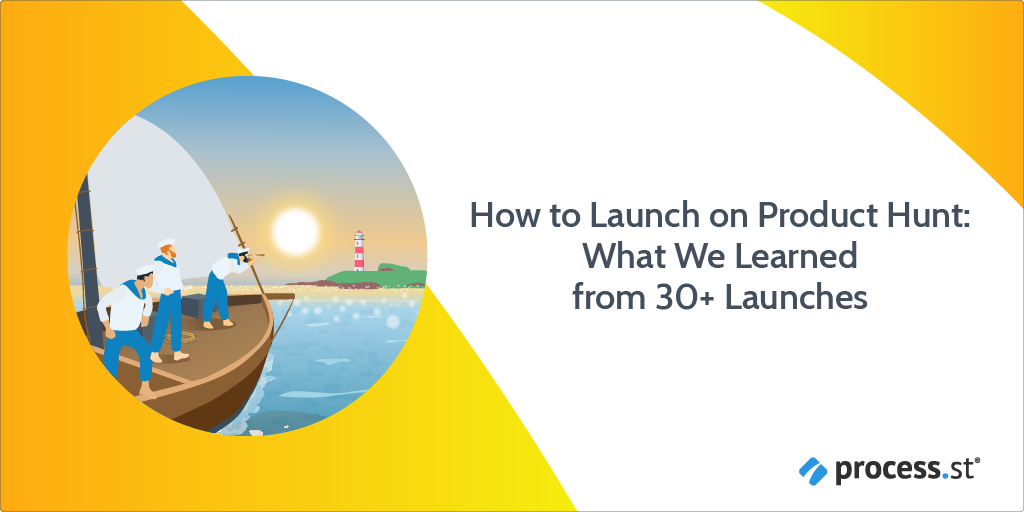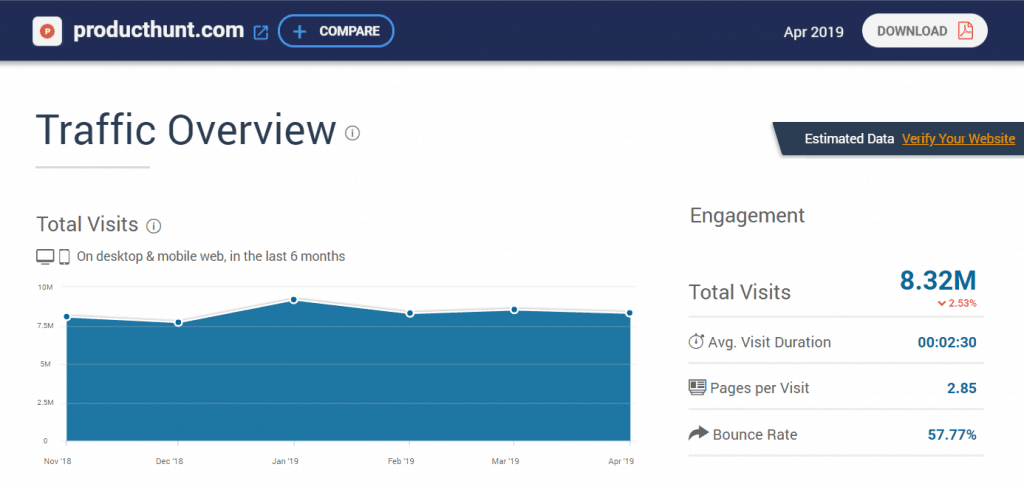
Way back in 2014, we first tried our hand at launching on Product Hunt with an early version of Process Street. It got featured, but that was a different time; when Product Hunt’s staff manually selected each product feature (these days Product Hunt claims that an automated algorithm decides).
It was hunted (Product Hunt lingo for “promoted”) by Audrey Melnik of Funnel Ventures, didn’t even have a maker (another Product Hunt termin for the creators of a product), yet still found its way to the front page of Product Hunt.
Six years, a couple of relaunches, and a $12 million Series A on from that humble effort, Process Street has changed a fair bit. We’ve shipped over 30 products on Product Hunt; from podcasts, new Process Street feature launches, to whole product launches, to eBooks.
Some of them were great successes, with multiple top 4 spots and a whole bunch of front-page features. Others weren’t so great; some garnered next to no traction and were essentially dead-on-arrival.
The point of this article is to impart some of the lessons we’ve learned, from common myths and misconceptions, to what worked well for us (and what didn’t work so well).
Here’s a breakdown of what I’ll be covering:
- Why you should care about Product Hunt
- Common misconceptions about Product Hunt launches
- How to prepare for a Product Hunt launch (free checklist)
- Key takeaways: How to have a successful Product Hunt launch
Let’s start with the basics, which often get taken for granted when it comes to deciding whether or not to launch on Product Hunt.
Why should you care about Product Hunt?
Quick answer: Because they have a huge platform and are a go-to location for tech enthusiasts to geek out about new products.
Or, in their own words:
According to Ahrefs, Product Hunt sees an average monthly organic search traffic of about 575,000 visits.

The figures above are just estimates for the top 100 organic search results; they don’t account for additional non-organic traffic sources (so only represent a fraction of the total monthly traffic).
But, such traffic estimates are often just that – estimates – so let’s look at what SEMrush has to say:

Quite a considerable variance, but this is probably due to Ahrefs only looking at the top 100 organic search results. The many, many organic results past the first 100 will no doubt make up for that additional ~500k visits.
Finally, Mert Aktas’ userguiding article on Product Hunt shows that in total, Product Hunt sees over 8 million monthly visits:

It’s also worth mentioning that Product Hunt operates a healthy Twitter account as well as a regular newsletter – both of which serve as channels to signal boost the lucky products they choose to feature.
All in all, for a free platform designed to help you share and promote your new products, that’s a pretty big deal. In simple terms, that means a potential audience of millions of Product Hunt users waiting to see your product.
So how do you get featured? What’s the best way to leverage Product Hunt and get in front of their huge audience?
Well, let’s first address a few common misconceptions around how to launch on Product Hunt.
Recap: How does Product Hunt work?
Product Hunt is a social community where people can create listings of products that they like. They can be their own products, or products other people have made. These listings get upvotes, and the top products are featured on Product Hunt’s homepage.
That’s how Product Hunt works, in simple terms. Product Hunt has “hunters”, which basically means “people who post products”. There are also “makers”, which are the roles reserved for the people who created the products. You can be both a hunter and a maker on your product.
Common misconceptions about a Product Hunt launch
Misconception #1: You need a famous hunter for your launch
Product Hunt has stated multiple times that it’s not necessary to reach out to “top Hunters” or influencers to get your product out there. Product Hunt on finding a hunter:
This may have been more important in the past when followers of a Hunter were notified whenever they “hunted” a new product, but this is no longer the case.
So, it’s probably not a great investment of time to spend too long worrying about who will hunt your product for the launch. Just hunt your own product!
Key takeaway: If you know a high-flying Hunter, go for it. But don’t let finding the perfect Hunter bottleneck your launch.
Bonus: If you’re still set on working with a Hunter for your launch, Davis Baer recently pulled together this public Twitter list of the top 500 Hunters on Product Hunt
Misconception #2: You need to be well-connected
Back in 2015, foundr ran a big piece on how to launch on Product Hunt. One of their key takeaways was that “you need to know a lot of people in the online space for a successful Product Hunt launch.”
I’d argue this is less relevant now than it was back in 2015. But there’s still some truth to it. Let’s unpack the statement and figure out what is still relevant.
What does it mean to be well-connected?
Let’s start with misconception #1. A big point foundr was making in their article was the importance Hunters played in the launch. We now know that Product Hunt doesn’t send email notifications for new products hunted by Hunters, so this aspect is less relevant.
However, being “well-connected” wasn’t just about knowing top Hunters. It was also about building traction and drumming up excitement for your product around and leading up to the launch. This is where the point is still relevant today.
The point here is that historically people have misinterpreted what Product Hunt values in a launch, placing disproportionate value on hunters to carry their product to Product Hunt’s front page.
Key takeaway: You should value the kind of connections that will help you to build communities around your product, whether via Slack groups, building and maintaining an email list, or any other kind of platform where users can congregate around and discuss your product.
Misconception #3: Upvotes = guaranteed feature
* Of course, we cannot reveal exactly how the algorithm works or it might be gamed. ” – Product Hunt, How do things end up on the homepage?
So getting featured is the result of a combination of factors, not just upvotes.
Product Hunt used to hand-pick features for their front page, but they claim this is no longer true.
Key takeaway: No-one can be sure exactly how Product Hunt selects features, since the algorithm is not public knowledge. One thing to be sure, relying on upvotes alone will not be good enough to secure yourself a featured product! Focus on communicating the value of your product, what problem it is solving, and what compelled you to build it.
Misconception #4: You’re penalized for linking directly to your product page
However, they do state that linking to producthunt.com is a bad idea, because it makes it harder for people to find you, and also may indicate that you are trying to “game the system.”
They also state that linking to your page and asking for upvotes is a “big no-no,” so this may be where some of the confusion around this point originates from.
Key takeaway: The point is to focus on authentic ways of communicating the value of your product, and avoid spammy behavior (which can actively hurt your Product Hunt ranking).
How to prepare for a Product Hunt launch (free checklist)
One of the best ways you can prepare for a Product Hunt launch is by using a checklist to run you through the essential steps.
Thankfully, Product Hunt has published a checklist of essentials for launching on their site, and we’ve made that even more actionable by building it into a handy Process Street checklist for you.
Click here to get the Product Hunt launch checklist, or check it out below:
This checklist will help you save time and effort by simplifying all of the action items around a Product Hunt launch into an easy-to-follow checklist.
You will also benefit from stop tasks to help with process enforcement and conditional logic to allow the checklist to adapt to various use cases. All of this makes following the process even easier, so you can have your VA or marketing coordinator run this checklist).
Best time to launch on Product Hunt

This is not a straightforward answer. Product Hunt is on PST; new products hit the homepage at 12:01 a.m. and are added throughout the day.
However, you must understand that Product Hunt is a global site with a global audience, meaning the best timing for you will depend on your product and your audience and geotargeting.
Popsters has published some great data on timing around Product Hunt launches. They looked at 32,657 projects over the course of 4 years, and took into consideration date and time of publication, product card images count, video availability, tags, hunter, upvotes count, and the relative positioning of the products across Product Hunt’s top listings.
Best time according to Popsters: Contrary to popular belief that Tuesday is the best day to publish, Sunday between midnight and one a.m. was the best day, with relatively higher chances to place higher in Product Hunt’s listings, as well as more upvotes.
Worst time according to Popsters: Wednesday and Thursday; and for any day after 12:00 p.m.activity decreases significantly.
I’d definitely recommend checking out this study, as it’s probably one of the most in-depth statistical analyses of Product Hunt launches out there, and it’s full of very easily readable graphs.
Key takeaways: What’s the best way to get featured on Product Hunt?
Here are some final takeaways for your consideration, based on our experience with 30+ Product Hunt launches, and aggregated information from long-term case studies:
- Hunt yourself: Prioritize speed and positioning over finding the perfect hunter.
- Consider publishing on the weekend: Because there are typically fewer people publishing on weekends, you have a higher chance of attracting attention.
- Visually compel your audience: You stand to gain a lot by making sure the images and video on your listing do the best job possible of communicating your value proposition and demonstrating your product.
- Be ready for your launch: Use a checklist to stay on top of your workflow and be sure you’re not missing any essentials!
Overall, there is a lot of luck involved in a Product Hunt launch, but there are many things you can do to ensure you get the most out of the platform.
Pay attention to statistics and be sure you have a plan in place for both best case and worst case scenarios. Best of luck!
Have you recently launched a product on Product Hunt? How did it go? What went well, and what didn’t? We’d love to hear about your experiences in the comments.







Oliver Peterson
Oliver Peterson is a content writer for Process Street with an interest in systems and processes, attempting to use them as tools for taking apart problems and gaining insight into building robust, lasting solutions.